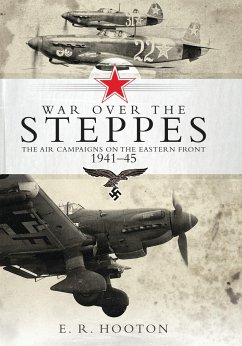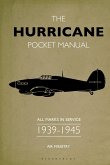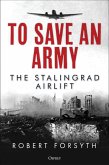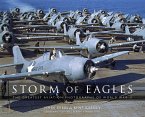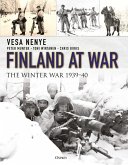- Gebundenes Buch
- Merkliste
- Auf die Merkliste
- Bewerten Bewerten
- Teilen
- Produkt teilen
- Produkterinnerung
- Produkterinnerung
This titanic clash between the pilots of the Third Reich and the Soviet Union from 1941 to 1945 remains one of the greatest conflicts in modern history.
Andere Kunden interessierten sich auch für
![The Hurricane Pocket Manual The Hurricane Pocket Manual]() Martin Robson (UK University of Exeter)The Hurricane Pocket Manual13,99 €
Martin Robson (UK University of Exeter)The Hurricane Pocket Manual13,99 €![To Save An Army To Save An Army]() Robert ForsythTo Save An Army29,99 €
Robert ForsythTo Save An Army29,99 €![Storm of Eagles Storm of Eagles]() John Dibbs (Author)Storm of Eagles34,99 €
John Dibbs (Author)Storm of Eagles34,99 €![The History of the Panzerwaffe The History of the Panzerwaffe]() Thomas AndersonThe History of the Panzerwaffe39,99 €
Thomas AndersonThe History of the Panzerwaffe39,99 €![Finland at War Finland at War]() Vesa NenyeFinland at War29,99 €
Vesa NenyeFinland at War29,99 €![The History of the Panzerwaffe The History of the Panzerwaffe]() Thomas AndersonThe History of the Panzerwaffe39,99 €
Thomas AndersonThe History of the Panzerwaffe39,99 €![Finland at War Finland at War]() Vesa NenyeFinland at War29,99 €
Vesa NenyeFinland at War29,99 €-
-
-
This titanic clash between the pilots of the Third Reich and the Soviet Union from 1941 to 1945 remains one of the greatest conflicts in modern history.
Hinweis: Dieser Artikel kann nur an eine deutsche Lieferadresse ausgeliefert werden.
Hinweis: Dieser Artikel kann nur an eine deutsche Lieferadresse ausgeliefert werden.
Produktdetails
- Produktdetails
- Verlag: Bloomsbury Trade / Osprey Publishing
- Seitenzahl: 288
- Erscheinungstermin: 20. Oktober 2016
- Englisch
- Abmessung: 238mm x 156mm x 32mm
- Gewicht: 650g
- ISBN-13: 9781472815620
- ISBN-10: 1472815629
- Artikelnr.: 44879595
- Herstellerkennzeichnung
- Libri GmbH
- Europaallee 1
- 36244 Bad Hersfeld
- gpsr@libri.de
- Verlag: Bloomsbury Trade / Osprey Publishing
- Seitenzahl: 288
- Erscheinungstermin: 20. Oktober 2016
- Englisch
- Abmessung: 238mm x 156mm x 32mm
- Gewicht: 650g
- ISBN-13: 9781472815620
- ISBN-10: 1472815629
- Artikelnr.: 44879595
- Herstellerkennzeichnung
- Libri GmbH
- Europaallee 1
- 36244 Bad Hersfeld
- gpsr@libri.de
E. R. (Ted) Hooton has been a journalist for 40 years and a defence journalist for about 25 years. He has written numerous articles on military history and three highly regarded books on the history of the Luftwaffe - The Luftwaffe: A Study in Air Power 1933-1945 (2010), Phoenix Triumphant: The Rise and Rise of the Luftwaffe (1992) and Eagle in Flames: The Fall of the Luftwaffe (1997), as well as contributing to several others. He has also written a detailed history of air operations over the Western Front, War over the Trenches - Air Power and the Western Front Campaigns 1916-1918 (2010) and Stalin's Claws (2012), an account of Stalin's military purges and the Soviet wars prior to Barbarossa.
Chapter 1: 1931-41This chapter traces the changing relationships between the two allies in a decade that saw them swing from co-conspirators against the Versailles Treaty to enemies. It examines the Luftwaffe build-up, which began during the Battle of Britain, and how the Mediterranean campaign would begin to effect the air war in the East like the 'Moon and the tides'. Soviet air power expanded explosively during the 1930s, but the huge air fleet had pilots who were barely trained. Moscow and Leningrad had air defences supported by radar, yet the flight to Moscow of a Lufthansa airliner sparked a purge of Soviet air leadership.Chapter 2: June 1941-April 1942The Luftwaffe had its greatest success destroying enemy air power in the opening hours of the campaign, but it destroyed aircraft and not men. The Soviet response was furious, but at terrible cost, allowing the Luftwaffe to pave the way for great advances that ended at the gates of Moscow. After that it covered the retreat and supplied isolated garrisons. These operations dissipated German air power, which could not escape the Wehrmacht's supply problems. It also allowed Luftwaffe commander in chief Herman Göring to consolidate his grip on the army's squadrons as the reconnaissance arm was reorganised. Russian air power was held together by its new commander, Pavel Zhigarev, yet he would leave only the lightest of footsteps on the sands of time. In response to the terrible blows that severely undermined the Soviet aircraft industry, Soviet air power was fragmented but Zhigarev laid the foundations for its consolidation and, in almost his last act, authorised development of the La-5 fighter. However, losses and a disrupted industrial base meant the USSR had to extemporise, possibly influenced by the clash at Khalin Gol in 1939, from obsolete aircraft and trainers the night bomber force that would be a significant element of their air power until the end of the warChapter 3: May 1942-February 1943.Air operations were greatly influenced by the characters of both side's leaders. The Luftwaffe was increasingly drawn into direct support of the army, especially on the Stalingrad front where the capricious von Richthofen played armchair general. The overstretched Luftwaffe had to rely increasingly on the slender reeds of its allies, and on the eve of the Soviet offensive at Stalingrad had only a single bomber to support the Italians and Hungarians. The situation was aggravated once more by the Mediterranean, to which there was a significant diversion of resources that effected the outcome at Stalingrad, where the Wehrmacht supply effort fell victim to personal rivalries. During this period the first German four-engined bombers were deployed in the newly formed night bomber units.Aleksandr Novikov had barely taken over the Soviet air force when he faced a series of crises leading to the Stalingrad battle, where the defending fighters were supported by radar. Nevertheless, Novikov persuaded Stalin to consolidate his regiments into air armies, one per front, and despite the severe difficulties of replacing men and machines he made the air force a more formidable and effective arm. Although it had great success during the winter of 1942/43, it continued to display significant weaknesses.Chapter 4: April 1943-April 1944Other theatres helped to shackle Luftwaffe operations in the east, the most significant of these being the defence of Germany - this slashed German fighter strength by a third just as the Red Army began to advance, leaving the Leningrad front with half-a-dozen fighters! But the Luftwaffe's biggest problem was the increasing swing from indirect to direct air support. Although an attempt was belatedly made to create a strategic bombing force, its initial operations were transporting supplies.Despite continued industrial weakness Novikov's airmen became more effective as they gained experience that improved their chances of survi
Chapter 1: 1931-41This chapter traces the changing relationships between the two allies in a decade that saw them swing from co-conspirators against the Versailles Treaty to enemies. It examines the Luftwaffe build-up, which began during the Battle of Britain, and how the Mediterranean campaign would begin to effect the air war in the East like the 'Moon and the tides'. Soviet air power expanded explosively during the 1930s, but the huge air fleet had pilots who were barely trained. Moscow and Leningrad had air defences supported by radar, yet the flight to Moscow of a Lufthansa airliner sparked a purge of Soviet air leadership.Chapter 2: June 1941-April 1942The Luftwaffe had its greatest success destroying enemy air power in the opening hours of the campaign, but it destroyed aircraft and not men. The Soviet response was furious, but at terrible cost, allowing the Luftwaffe to pave the way for great advances that ended at the gates of Moscow. After that it covered the retreat and supplied isolated garrisons. These operations dissipated German air power, which could not escape the Wehrmacht's supply problems. It also allowed Luftwaffe commander in chief Herman Göring to consolidate his grip on the army's squadrons as the reconnaissance arm was reorganised. Russian air power was held together by its new commander, Pavel Zhigarev, yet he would leave only the lightest of footsteps on the sands of time. In response to the terrible blows that severely undermined the Soviet aircraft industry, Soviet air power was fragmented but Zhigarev laid the foundations for its consolidation and, in almost his last act, authorised development of the La-5 fighter. However, losses and a disrupted industrial base meant the USSR had to extemporise, possibly influenced by the clash at Khalin Gol in 1939, from obsolete aircraft and trainers the night bomber force that would be a significant element of their air power until the end of the warChapter 3: May 1942-February 1943.Air operations were greatly influenced by the characters of both side's leaders. The Luftwaffe was increasingly drawn into direct support of the army, especially on the Stalingrad front where the capricious von Richthofen played armchair general. The overstretched Luftwaffe had to rely increasingly on the slender reeds of its allies, and on the eve of the Soviet offensive at Stalingrad had only a single bomber to support the Italians and Hungarians. The situation was aggravated once more by the Mediterranean, to which there was a significant diversion of resources that effected the outcome at Stalingrad, where the Wehrmacht supply effort fell victim to personal rivalries. During this period the first German four-engined bombers were deployed in the newly formed night bomber units.Aleksandr Novikov had barely taken over the Soviet air force when he faced a series of crises leading to the Stalingrad battle, where the defending fighters were supported by radar. Nevertheless, Novikov persuaded Stalin to consolidate his regiments into air armies, one per front, and despite the severe difficulties of replacing men and machines he made the air force a more formidable and effective arm. Although it had great success during the winter of 1942/43, it continued to display significant weaknesses.Chapter 4: April 1943-April 1944Other theatres helped to shackle Luftwaffe operations in the east, the most significant of these being the defence of Germany - this slashed German fighter strength by a third just as the Red Army began to advance, leaving the Leningrad front with half-a-dozen fighters! But the Luftwaffe's biggest problem was the increasing swing from indirect to direct air support. Although an attempt was belatedly made to create a strategic bombing force, its initial operations were transporting supplies.Despite continued industrial weakness Novikov's airmen became more effective as they gained experience that improved their chances of survi

